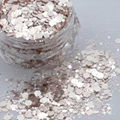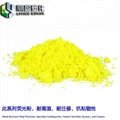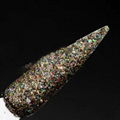Basic knowledge of sensitizing color spectrum
Ultraviolet rays are classified into three types according to different wavelength bands, and those having a wavelength below 250 (nm) are called UVC; those having a wavelength of 250-320 (nm) become UVB; and wavelengths of 320-380 (nm) are called UVA. The visible range is 380-800 (nm).
Photochromic principle
Using the energy of UVA to open the photoreceptor molecule, he jumps from the low energy stage to the high energy stage. That is, jumping from invisible light to visible light, thereby producing a color change. When the ultraviolet radiation is lost or the temperature rises above 45 degrees, the photosensitive molecular bond is turned off, that is, the original color is restored.
Photochromic powder product introduction:
Photosensitive MC powder is colorless in the absence of ultraviolet light indoors. After being exposed to sunlight/ultraviolet light outdoors, it absorbs sunlight/ultraviolet energy and produces color changes. When it loses sunlight/ultraviolet light, it returns to colorless or original. colour.
The photosensitive MC powder is a photosensitive color-changing product. The principle of discoloration is to absorb the ultraviolet light source of a specific wavelength, and the color change (becomes purple, red, yellow, etc.) is generated by the energy of the light source, and when the ultraviolet light source of a specific wavelength is absent, the light is recovered. The original color. The photosensitive MC powder is a product processed by the microcapsule technology, and has a powdery appearance and a particle diameter of 1 to 10 μm, and has characteristics of being modified by microcapsules such as high temperature resistance and oxidation resistance. Photosensitive MC powder can be applied to various industries such as coatings, inks and plastics. The design of products is mostly based on indoor (no ultraviolet light environment) and outdoor (with ultraviolet light environment) color change.
Application of pigments and screen printing inks:
Photosensitive MC powder is dispersed in paints and inks and is not dissolved in paints and inks.
There may be different hue depending on the polarity. It can be applied to oily and water-based paints and inks.
The recommended ratio of screen printing is 20%-30%, generally 25%.
Recommended ratio of silicone, injection molding, injection: 5%
Suitable for all types of printing, including screen printing, gravure printing and letterpress printing
A printed background is recommended to use a white or light color to increase the difference in color change.
For printing different materials, a suitable coating or ink substrate should be used.
Plastic injection and extrusion applications:
Can be applied to the processing of various plastics, such as PP, PE, PVC, PU, PS, etc.
When processing, firstly use white wax oil to wet the plastic material (note that the amount of white wax oil should not exceed 2% of the plastic material), then add the color changing powder to the plastic material and mix well. When mixing, pay attention to dispersibility and poor dispersion. Add an appropriate amount of dispersant.
Can be mixed with different toners to match a variety of color changes.
Processing at temperatures above 250 °C should be avoided as much as possible.
When processing, 20% of the MC powder content of the antioxidant and 20% of the heat stabilizer can be added to improve the stability.
The photo-staining material is caused by light fatigue, caused by excessive UV exposure, acid, free radicals (single-state oxygen atoms) and humidity. It is generally recommended to add UV absorbers and antioxidants to increase the anti-light fatigue.
Additives such as antioxidants and thermal stabilizers used in photochromic materials can improve the light fatigue resistance. However, the combination and selection of additives depend on the medium used. The wrong combination formula will accelerate the light fatigue.
Product use precautions:
Avoid using it with UV absorbers. Sensitivity to polarity, the addition of different additives or the use of different substrates may cause chromatic aberration.
Toxicity and safety:
Photosensitive MC powder is non-destructive to the skin, does not contain harmful substances, and meets the standards for safe toys and food packaging.
Storage
Photochromic materials should be sealed and stored in a closed, dry, dark place, away from direct sunlight.











